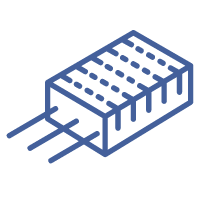
- Contact Plating
Contact plating (finish) provides corrosion protection for base metals and optimizes the mechanical and electrical properties of the contact interfaces.
Lead, Tin - MountThrough Hole
- Mounting TypeSurface Mount
- Package / CaseSSOP-16
- RoHSCompliant
- Supplier PackageSSOP
- MountingSurface Mount
- PackageTape & Reel (TR);Cut Tape (CT);Digi-Reel®;
- Base Product NumberAS5145
- Mframs OSRAM
- Product StatusActive
- Output Signal TypeDigital
- Moisture SensitiveYes
- Maximum Output Current4 mA
- Release Point Min/Max (Brp)-
- QualificationAEC-Q100
- Operating Point Min/Max45 mT to 75 mT
- Maximum Operating Temperature
the maximum body temperature at which the thermistor is designed to operate for extended periods of time with acceptable stability of its electrical characteristics.
+ 150 C - Unit Weight0.168198 oz
- Minimum Operating Temperature- 40 C
- Factory Pack QuantityFactory Pack Quantity500
- Mounting StylesSMD/SMT
- Shaft TypeNo Shaft
- Part # Aliases177710101 Q65114A0598
- Manufacturerams OSRAM
- Brandams OSRAM
- Packaging
Semiconductor package is a carrier / shell used to contain and cover one or more semiconductor components or integrated circuits. The material of the shell can be metal, plastic, glass or ceramic.
Bulk - Operating Temperature
The operating temperature is the range of ambient temperature within which a power supply, or any other electrical equipment, operate in. This ranges from a minimum operating temperature, to a peak or maximum operating temperature, outside which, the power supply may fail.
-40 to 150 °C - SeriesAutomotive, AEC-Q100
- Tolerance1 %
- Number of Terminations2
- Temperature Coefficient
The resistance-change factor per degree Celsius of temperature change is called the temperature coefficient of resistance. This factor is represented by the Greek lower-case letter “alpha” (α). A positive coefficient for a material means that its resistance increases with an increase in temperature.
50 ppm/°C - TypeRotational
- Resistance3 Ω
- Max Operating Temperature
The Maximum Operating Temperature is the maximum body temperature at which the thermistor is designed to operate for extended periods of time with acceptable stability of its electrical characteristics.
250 °C - Min Operating Temperature-55 °C
- CompositionWirewound
- SubcategorySensors
- Power Rating3 W
- Max Power Dissipation
The maximum power that the MOSFET can dissipate continuously under the specified thermal conditions.
3 W - Voltage - Supply3V ~ 3.6V, 4.5V ~ 5.5V
- Orientation-
- Supply Voltage3 V
- Military StandardMIL-PRF-39007
- Pin Count
a count of all of the component leads (or pins)
16 - Termination StyleSMD (SMT) Tab
- Actuator TypeExternal Magnet, Not Included
- Output TypeQuadrature (Incremental)
- Lead Length38.1 mm
- Operating Supply Voltage
The voltage level by which an electrical system is designated and to which certain operating characteristics of the system are related.
1.9, 3.6 V - Failure Rate
the frequency with which an engineered system or component fails, expressed in failures per unit of time. It is usually denoted by the Greek letter λ (lambda) and is often used in reliability engineering.
0.001 % - Operating Supply Current16 mA
- Resolution4096 PPR
- Product Type
a group of products which fulfill a similar need for a market segment or market as a whole.
Hall Effect / Magnetic Sensors - Screening LevelExtended Industrial
- Built in SwitchNo
- Encoder Type
An encoder is classified into four types: mechanical, optical, magnetic, and electromagnetic induction types.
Magnetic - DetentNo
- Pulses per Revolution
Pulses per revolution (or PPR) is a parameter associated with encoders. Basically, it is a measure of the number of pulses per full revolution or turn of the encoder, with a full revolution being 360 degrees. In essence, it is a measure of an encoder's resolution.
4096 - Rotational Life (Cycles Min)-
- ProductMagnetic Encoders
- FeaturesMilitary, Moisture Resistant
- Product Category
a particular group of related products.
Board Mount Hall Effect / Magnetic Sensors - Width4.75 mm
- Length14.224 mm
- Diameter4.75 mm
- Lead FreeContains Lead








